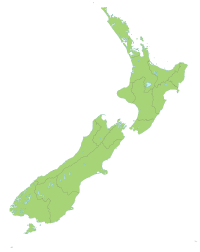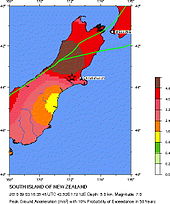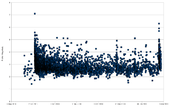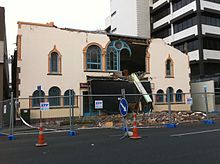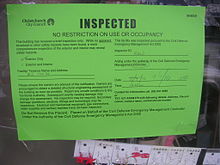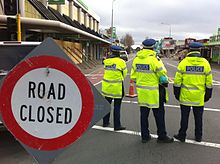- 2010 Canterbury earthquake
-
For the severe aftershock of 22 February 2011, see 2011 Christchurch earthquake.
2010 Canterbury earthquake
Quake epicentreDate 4 September 2010 4:35 am NZST Magnitude 7.1 Mw[1][2] Depth 10 km (6.2 mi)[2] Epicenter 43°33′S 172°11′E / 43.55°S 172.18°ECoordinates: 43°33′S 172°11′E / 43.55°S 172.18°E, near Darfield, Canterbury Countries or regions New Zealand Max. intensity MMX[3] Peak acceleration 1.26 g[4] Aftershocks ~7,000 (as of early June 2011)[5] Casualties 2 seriously injured, approximately 100 total injuries[6] The 2010 Canterbury earthquake (also known as the Christchurch earthquake or Darfield earthquake) was a 7.1 magnitude earthquake,[1][2] which struck the South Island of New Zealand at 4:35 am on 4 September 2010 local time (16:35 3 September UTC).[1]
The quake caused widespread damage and several power outages, particularly in the city of Christchurch, New Zealand's second largest city.[6][7] Two residents were seriously injured, one by a collapsing chimney and a second by flying glass.[6][8] One person died of a heart attack suffered during the quake, although this could not be directly linked to the earthquake.[6][8] Mass fatalities were avoided partly due to there being few houses of unreinforced construction, although this was also aided by the quake occurring during the night when most people were off the street.[9][10]
The earthquake's epicentre was 40 kilometres (25 mi) west of Christchurch,[11] near the town of Darfield. The hypocentre was at a shallow[11] depth of 10 km.[1] A foreshock of roughly magnitude 5.8 hit five seconds before the main quake,[12] and strong aftershocks have been reported,[6][13] up to magnitude 6.3.[14] The initial quake lasted about 40 seconds,[7] and was felt widely across the South Island, and in the North Island as far north as New Plymouth.[15] As the epicentre was on land away from the coast, no tsunami occurred.[11]
The National Crisis Management Centre in the basement of the Beehive in Wellington was activated, and Civil Defence declared a state of emergency for Christchurch, the Selwyn District, and the Waimakariri District, while Selwyn District, Waimakariri and Timaru activated their emergency operation centres.[16] Initially, a curfew was established for parts of Christchurch Central City from 7:00 pm to 7:00 am in response to the earthquake. The New Zealand Army was deployed to the worst affected areas within Canterbury.[8]
Aftershocks have continued into 2011, with some causing significant damage themselves. The strongest to date occurred on 22 February 2011 which is so far estimated at magnitude 6.3.[17] It was felt from Invercargill to Wellington.[18] 181 people have been confirmed dead.[19]
Claims from the earthquake were confirmed at being between $2.75 and $3.5 billion NZD.[20]
Contents
Geological background
In the first eighty years of European settlement in Christchurch (1850–1930), four earthquakes caused significant damage, the last of them occurring in 1922 at Motunau.[21]
Modelling conducted for the New Zealand Earthquake Commission (EQC) in 1991 found that earthquakes with a Mercalli intensity of VIII (significant property damage, loss of life possible) could recur on average in the Christchurch area every 55 years. The study also highlighted the dangers of soil liquefaction of the alluvial sediments underlying the city, and the likelihood of significant damage to water, sewer and power supply services.[22]
About 100 faults and fault segments have been recognised around the region, some as close as 20 km to central Christchurch. The closest faults to Christchurch capable of producing powerful earthquakes are found in the Rangiora-Cust area, near Hororata, and near Darfield.[23] However, the 2010 quake occurred on a previously unknown fault. Scientists are investigating whether the main 2010 quake may have actually been two or three almost simultaneous earthquakes.[12]
The main quake occurred as a result of strike-slip faulting within the crust of the Pacific plate, near the eastern foothills of the Southern Alps at the western edge of the Canterbury Plains.[24] The earthquake epicentre is located about 80–90 km (50–56 mi) to the south and east of the current surface expression of the Australia–Pacific plate boundary through the island (the Alpine and Hope Faults).[24] Though removed from the plate boundary itself, the earthquake likely reflects right-lateral motion on one of a number of regional faults related to the overall relative motion of these plates and may be related to the overall southern propagation of the Marlborough Fault System in recent geologic time.[24] The peak ground acceleration measured near Darfield was 1.26g (12.36 m/s2) , recorded near Darfield.[4] This was considered by GNS scientists as an "extremely rare seismic recording made near a fault rupture".[25] However, the February 2011 Christchurch earthquake experienced PGA of 2.2 g.
Aftershocks
As of 15 June 2011[update], 7,420+ aftershocks of magnitude 2 or more have been recorded, including 26 over 5.0 magnitude, and 2 over 6.0 magnitude.[26] Many have caused further damage to buildings in the central business district, and been felt as far away as Dunedin.[27][28][29][30]
On 8 September 2010, there was a large 5.1 magnitude aftershock with an epicentre just 7 km from the city centre.[31]
On 19 October 2010 a magnitude 5.0 aftershock with a depth of just 9 km which caused surface shaking reported at the time to be the worst since the original earthquake.
On 26 December 2010, Boxing Day, a swarm of more than 32 shallow aftershocks,[26] many centred directly under the city,[32] occurred throughout the day beginning with a 4.2 jolt at 2:07am. The largest of these, the "Boxing Day aftershock", with a magnitude of 4.9, at a depth of 12 km below Opawa[33] was felt very strongly and caused further damage to at least 20 buildings, the closure of the central city,[34] and cut power to more than 40,000 for some time.[35]
On 20 January 2011 a magnitude 5.1 aftershock with a depth of 10 kilometres (6.2 mi) struck at 6:03am, waking many residents. The shock caused some minor damage and was felt as far away as the West Coast and Oamaru.[36]
On 6 June 2011 a magnitude 5.5 aftershock with a depth of 15 km centred in Rolleston occurred at 9:09am causing power cuts and supermarkets to close. The shock was felt widely in the South Island with reports as far South as Dunedin and as far North as Nelson. It was the sixth largest aftershock since the magnitude 7.1 shake in September 2010.[37]
On 21 June 2011 a magnitude 5.4 aftershock with a depth of 8 km centred south-west of Halswell occurred at 10:34pm.[38] The shock was felt heavily in Christchurch, causing moderate-heavy content damage in western suburbs such as Upper Riccarton and Hornby. Halswell New World reported that more stock had fallen from shelves in this shake than in the 22 February and 13 June quakes.[39]
On 22 July 2011 a magnitude 5.1 aftershock with a depth of 12 km occurred at 5:39am.[40]
22 February aftershock
Main article: February 2011 Christchurch earthquakeAn earthquake of (local) magnitude 6.3 occurred on 22 February 2011, centred at Heathcote Valley, 5 kilometres (3.1 mi) from Lyttelton and at a depth of 5 kilometres (3.1 mi). It is regarded by seismologists as an aftershock of the 2010 earthquake. Many buildings collapsed or were significantly damaged in the quake, among them the city's iconic ChristChurch Cathedral. As of 1 June 2011, 181 people have been confirmed dead.[17]
13 June aftershock
Main article: June 2011 Christchurch earthquakeA magnitude 6.3 earthquake struck Christchurch on 13 June 2011 at a depth of 6 kilometres (3.7 mi). It was preceded by a moderate magnitude 5.6 tremor, and affected many structures previously damaged by other earthquakes. The earthquake injured a total of 46 people, while many others were evacuated from the city centre.[41]
Quake analysis
At least two models for the quake have been put forward by GNS seismologists and geophysicists, who believe the 7.1 Mw quake consisted of three or four separate quakes.[42] Dr John Beavan has a four-fault model consisting of a 6.5 Mw quake on the Charing Cross fault, followed by a 7.0 Mw quake on the Greendale Fault, and a 6.2 Mw quake near Hororota, with a 6.5 Mw quake on the fourth fault, which could run between West Melton, Sandy Knolls and Burnham.[42] Dr Caroline Holden has a three-fault model, consisting of a 6.3 Mw quake of 2 – 4 seconds on the Charing Cross fault, followed by a 6.9 Mw quake lasting 7 – 18 seconds on the Greendale Fault, and an approximately 6.5 Mw quake of 15 – 18 seconds near Hororota, but she too is examining whether a four-fault model would create a better fit for seismograms recorded east of the Greendale fault, near the hypothetical fourth fault.[42]
Geotechnical reports
The Earthquake Commission has published two Geotechnical Land Damage Assessment & Reinstatement Report[s]. The first Stage-1 report [43] was published on 21 October 2010. The report briefly describes the mechanics of the earthquake, underlying geology, residential land damage assessment, reconstruction considerations, land and building reinstatement, and remediation options.
The second Stage-2 report [44] was published on 1 December 2010. It divides the quake affected areas into three zones, and outlines the remediation plans for these areas.
Casualties, damage, and other effects
Most of the damage was in the area surrounding the epicentre, including the city of Christchurch, New Zealand's second-largest urban area with a population of 386,000. Minor damage was reported as far away as Dunedin and Nelson, both around 300–350 kilometres (190–220 mi) from the earthquake's epicentre.[45]
The September 2010 earthquake caused two Christchurch residents to be seriously injured, one by a falling chimney and a second by flying glass, and led to many with less serious injuries. One person died of a heart attack suffered during the quake, but doctors could not determine whether the quake was the cause.[6][8]
The 22 February 2011 aftershock caused a large number of deaths and casualties, along with significant damage to buildings and infrastructure. Details of this damage is listed in the article on that aftershock.
Financial exposure
Total Earthquake Commission (EQC), private insurance and individual costs may reach as high as NZ$4 billion according to the New Zealand Treasury.[28] Another projection of the cost covered by insurance (including EQC) was lower at $2.1 billion to $3.5 billion, but would still rank the quake as the world's fifth most costly to insurers.[46]
The Earthquake Commission covers only domestic residences with private insurance and does not provide cover for businesses. The EQC payout is limited to the first $100,000 plus GST of any individual claim, with any amount above that covered by the insurance company holding the policy. The insurance companies themselves had limited or no exposure, having offloaded most of their risk to reinsurance companies. The EQC has reinsurance of $2.5 billion with a $1.5 billion excess, so its exposure is the first $1.5 billion and any amount after the first $4 billion. It had a total fund prior to this earthquake of approx $6 billion.[47]
For a comparison, the 1931 Hawke's Bay earthquake cost NZ£7 million,[48] equal to approximately $650 million in 2010 dollars.[49]
Effects in Christchurch
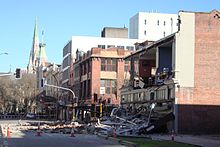 Building damage in Worcester Street, corner Manchester Street, with Christchurch Cathedral in the background
Building damage in Worcester Street, corner Manchester Street, with Christchurch Cathedral in the background
Reports of the quake's intensity in Christchurch generally ranged from IV to VIII (moderate to destructive) on the modified Mercalli scale.[45] A strong smell of sulphur was widely reported in Christchurch following the earthquake.[50] Sewers were damaged,[51] and water lines were broken. The water supply at Rolleston, located to the southwest of Christchurch, was contaminated. Power to up to 75 percent of the city was disrupted.[52] Christchurch Hospital was forced to use emergency generators in the immediate aftermath of the quake.[52] About 90% of the electricity in Christchurch had been restored by 6:00pm the day of the earthquake. The repair of electricity was estimated to be more difficult in the rural areas.[53] One building caught fire after its electricity was turned back on, igniting leaking LPG in the building. The fire was quickly extinguished by the Fire Service before it could spread.[54] Damage to buried pipes may have allowed sewage to contaminate the residential water supply. Residents were warned to boil tap water before using it for brushing teeth, drinking, and washing or cooking food. Several cases of gastroenteritis were reported.[55][56] By 7 September, 28 cases had been observed at the city's welfare centres.[57] The boil water notice for Christchurch and Banks Peninsula was lifted late on 8 September 2010, after more than 500 tests conducted over three days found no contamination.[58]
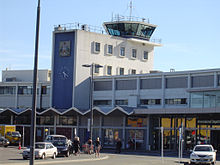 Christchurch International Airport was closed for a few hours following the quake.
Christchurch International Airport was closed for a few hours following the quake.
Christchurch International Airport was closed following the earthquake and flights in and out of it cancelled. It reopened at 1:30 pm, following inspection of the terminals and main runway.[59] All schools and early childhood centres in Christchurch City, Selwyn and Waimakariri Districts were ordered shut until Monday 13 September for health and safety assessments.[60][61] The city's two universities, the University of Canterbury and Lincoln University, and the Christchurch campus of the University of Otago were also closed until 13 September awaiting health and safety assessments.[62]
Crime in Christchurch decreased eleven percent compared with the previous year following the earthquake, although there were initial reports of looting in the city centre and "known criminals" trying to pass off as council workers to get into the central city cordon area. Police also observed a fifty-three percent jump in the rates of domestic violence following the earthquake.[63] Many more heart attacks than usual were reported in the days following the quake. Usually the heart unit at Christchurch Hospital handles two to three heart attacks a day, but the rate had risen to eight to ten a day since the earthquake.[64] A record number of babies for a Saturday were born at Christchurch Women's Hospital in the twenty-four hours after the quake,[65] with the first baby arriving six minutes after the initial shock.[66] This was at least in part due to outlying birthing centres being closed,[67] pending structural checks, forcing more mothers to deliver at hospitals than was generally the case.
Effects outside Christchurch
The quake's epicentre was around Darfield, around 40 kilometres (25 mi) from Christchurch.[68] Four metres (13 ft) of sideways movement has been measured between the two sides of the previously unknown fault.[12]
In many towns outside Christchurch, the electrical grid was disrupted, with it taking an estimated two days to fully restore power to those affected.[69][70] Power outages were reported as far away as Dunedin.[71]
Access was restricted to over 350 homes in the town of Kaiapoi, of which about 100 were deemed unsafe.[72] Some 22 commercial properties were deemed unsafe. According to Ron Keating, Mayor of Waimakariri District, the town "will never be the same again".[73] As noted above, damage to buried pipes may have allowed sewage to contaminate the residential water supply, and residents were warned to boil tap water before using it for brushing teeth, drinking, and washing or cooking food. A boil water notice for most of Selwyn District was lifted on 9 September.[74] E. coli has been found in a water sample from Kaiapoi,[75] and a boil water notice remained in effect for parts of Waimakariri District until 19 September.[76][77]
A 5 km (3.1 mi) section of rail track was damaged near Kaiapoi and there was lesser track damage at Rolleston and near Belfast.[78] As a precaution, state rail operator KiwiRail shut down the entire South Island rail network after the earthquake, halting some 15 trains. Two locomotives running light (i.e. without any carriages or wagons) came to a stop just 30 metres short of a major buckle in the line.[79] After inspection, services south of Dunedin and north of Kaikoura recommenced at 10:30 am that day.[80] The Main South Line, linking Christchurch with Dunedin, was given the all-clear and reopened, albeit with a 40 km/h speed restriction north of Ashburton,[79] just after 6:00 pm to allow emergency aid, including 300,000 litres (70,000 imp gal; 80,000 US gal) of drinking water, to be railed into Christchurch.[81] By the afternoon of Monday 6 September, the entire South Island rail network had reopened with the exception of the Main North Line between Rangiora and Addington. Freight was shuttled by road between the two points, while the TranzCoastal was replaced with a coach service.[79]
Major bridges on State Highways and the Lyttelton road tunnel were inspected by the New Zealand Transport Agency, and found to be in structurally sound condition. The only major road closure outside Christchurch was a slip in the Rakaia Gorge, blocking State Highway 77. The slip was partially cleared by 4:00 pm to allow a single lane of traffic through the site.[82][83] Kaiapoi's main road was closed for a few days.[84]
The quake caused damage to historic buildings in Lyttelton, Christchurch's port town, including cracks in a church and the destruction of parts of a hotel.[68] The Akaroa area of Banks Peninsula came through the earthquake relatively unscathed, though there was some damage to the town's war memorial and hospital[85] and some homes were extensively damaged. Duvauchelle Hotel was also seriously affected.[86]
In Oamaru, 225 kilometres southwest of Christchurch, the earthquake caused part of a chimney on the St Kevin's College principal's residence to fall through the house, and caused the clock atop the Waitaki District Council building to stop at 4:36am. The earthquake also caused the Dunedin Town Hall clock and the University of Otago clocktower to stop working in Dunedin, some 350 km away from the quake epicentre.[87]
The earthquake was a wake-up call to many New Zealand residents. Two Dunedin supermarkets sold out of bottled water following the earthquake as people stocked up on emergency supplies.[87]
Major stores across the South Island were affected as their distribution centres in Christchurch were closed. Both The Warehouse[88] and Progressive Enterprises (owners of Countdown),[89] which have their sole South Island distribution centres in Christchurch, had to ship essential products to their South Island stores from the North Island, while Foodstuffs (owners of New World and Pak'n Save) had to ship to all their South Island stores from their Dunedin distribution centre.[90]
Notable buildings
Many of the most badly affected structures in both Christchurch and the surrounding districts were older buildings, including several notable landmarks. New Zealand Historic Places Trust board member Anna Crighton said the earthquake had been "unbelievably destructive." The historic homesteads of Hororata and Homebush inland from Christchurch were both extensively damaged, as were Ohinetahi homestead and Godley House on Banks Peninsula.[91] Homebush, located at Glentunnel only 15 kilometres from the earthquake's epicentre, was the historic home of the Deans family, one of the Canterbury Region's pioneer settler families, but was so extensively damaged that it has been described as being "practically in ruins".[92]
The seven-storey Manchester Courts (or MLC Building[93]), located at the busy intersection of Manchester and Hereford Streets, was extensively damaged. It was the tallest commercial building in Christchurch when it was built in 1905–06 for the New Zealand Express Company, and blended 1890s Chicago Skyscraper style with English Edwardian architecture. The building had a Category One Historic Places trust classification, but was deemed unsafe and was one of just two historic CBD buildings the City Council initially proposed for immediate demolition.[94] That decision was reversed hours later when the building's owner proposed to dismantle the building over several weeks.[95] Demolition began on 19 October 2010 and was continuing in late January.[96]
The 1911 Anglican church of St. John in Hororata, five kilometres south of Glentunnel, was extensively damaged when part of its tower collapsed.[97] The port town of Lyttelton's most notable building, the 1876 Timeball station, was also affected by the earthquake, though strengthening work completed in 2005 may have saved it from further damage.[91] In the later Christchurch earthquake in February 2011 the building was severely damaged, and it is planned by the New Zealand Historic Places Trust for it to be dismantled, with the possibility of reconstruction.[98].
The Valley Inn Tavern in Heathcote, built in 1877, survived the initial quake, but had to be torn down after the large 5.1 magnitude aftershock.[99] Lincoln's historic 1883 public house, The Famous Grouse, was also irreparably damaged and was demolished within days of the earthquake.[100]
Many of Christchurch's major landmarks survived intact, including the Canterbury Provincial Council Buildings, the Anglican cathedral, and Christ's College.[101] The Catholic Cathedral of the Blessed Sacrament (Christchurch Basilica) also survived, although it suffered severe structural damage and also had some windows broken. The central city's iconic Christchurch Press building also survived with only minor damage.
Most modern buildings performed as they were designed to do, preserving life rather than keeping the interior in good order. The City Council's own new Civic Building sustained some interior damage, mainly to fixtures and fittings that delayed it being reopened for a week.[102] Others, such as the city's International Antarctic Centre and Christchurch Art Gallery, the latter of which served as the Civil Defence Headquarters during the earthquake aftermath,[86] suffered little or no damage and were able to be used immediately.
Christchurch Arts Centre, housed in the former Canterbury College buildings, was less fortunate, with moderate damage to the Great Hall, the Clocktower, and the Observatory.[91]
The structure of the University of Canterbury's buildings survived the earthquake, but its museum collection of Greek and Roman artefacts (the Logie Memorial Collection) was significantly damaged.[103] Also, as many of the bookshelves in the main library were toppled, with repairs expected to take until Christmas, the University arranged electronic access to many academic publishers databases for students about to sit exams.
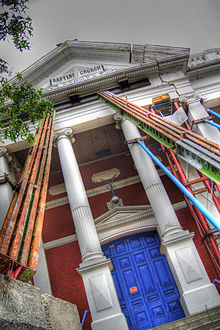 View of the Oxford Terrace Baptist Church after the 2010 Canterbury earthquake, with props holding the frontage up (It was later destroyed in the February 22 aftershock).
View of the Oxford Terrace Baptist Church after the 2010 Canterbury earthquake, with props holding the frontage up (It was later destroyed in the February 22 aftershock).
The Oxford Terrace Baptist Church, constructed 1881–1882, was extensively damaged.[104] Several other Christchurch area churches also suffered serious damage, including St. Mary's Anglican church in Merivale, St. John's Anglican church in Latimer Square, and the Rugby Street Methodist church.[105]
The city's Repertory Theatre, on Kilmore Street in the central city, was reported to be extensively damaged and may be beyond repair,[106] however the Repertory Theatre website notes "Beneath the rubble the lower façade is intact with not even a broken window. Further into the theatre everything was undisturbed; the auditorium, stage area, fly tower and dressing rooms intact. The historic proscenium undamaged."[107]
Several notable buildings in the Timaru area, 160 kilometres (99 mi) southwest of Christchurch, were also badly affected. A pinnacle on the tower of St Mary's Anglican Church tower fell to the ground, and the recently restored tower itself sustained "significant cracking".[108] The spire of St. Joseph's Catholic Church in Temuka was also shifted 10 centimetres (4 in) by the earthquake, leaving it precariously balanced, and the town's historic Royal Hotel was also damaged.[109]
Heritage experts urged building owners not to hastily demolish their buildings. The mayor warned of significant penalties for demolishing buildings without consent, and launched a fund to help repair historic buildings damaged by the quake.[110] The Government allocated NZ$10 million towards restoration of such buildings a few days later.[111]
Liquefaction
A feature of the quake was the damage caused by soil liquefaction. This was particularly the case in the riverside areas of Avonside, Dallington, Burwood, Avondale, and Kaiapoi, and in river delta areas near Bexley, Brooklands, Spencerville, Pines Beach, and Kairaki with other areas being affected to a substantially lesser degree or not at all.[43] Damage from liquefaction may have been worsened by the high water table from a wet winter.[112]
Liquefaction can also cause buried pipes to float up to the surface. This has caused problems for the gravity-fed sewer system, which may need to be completely rebuilt in some areas.[113]
While the problem had long been well understood by planners,[114][115][116] it is not clear that the public understood it as well, or that it widely influenced development, buying or building decisions.[117] Liquefaction risk at the Pegasus Town site was identified in 2005, so the developers spent approximately $20 million on soil compaction, and the ground there held firm during the quake.[112]
Relative lack of casualties
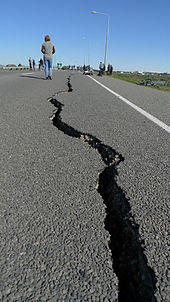 Crack in Bridge Street, South New Brighton
Crack in Bridge Street, South New Brighton
The media have remarked on the lack of casualties, despite the close parallels of the quake to incidents that have had devastating consequences in other countries, such as the 1989 San Francisco Quake, that killed 63 people and was magnitude 7.1 also. The analysis especially compared the Canterbury quake with the 2010 Haiti earthquake, which also occurred in similar proximity to an urban area, also occurred at shallow depth under the surface, and was of very similar strength. Unlike many tens of thousands of deaths in Haiti (with some estimates placing the death toll at one in ten or higher), no deaths directly attributable to the earthquake were reported in New Zealand.[118] This was ascribed to the fact that the quake happened in the early hours of a Saturday morning, when most people were asleep[10] in timber framed homes, and "...there would almost certainly have been many deaths and serious injuries had it happened during a busy time of the day...".[119] Another important factor was building practices which took earthquakes into account, starting after the 1848 Marlborough earthquake and the 1855 Wairarapa earthquake, both of which badly affected Wellington.[118] These led to formal standards after the 1931 Hawke's Bay earthquake,[120][121] which have since been progressively updated.[122] By contrast, Haiti's much lower standard codes were poorly enforced and many buildings were made of hand-made non-reinforced concrete, which is extremely vulnerable to seismic damage.[123] Ground shaking in populated areas of Canterbury was also generally less strong than for the Haiti quake.[124][125]
Emergency response and relief efforts
Christchurch's emergency services managed the early stages of the emergency as the Civil Defence organisation was activated. The St John Ambulance service had sixteen ambulances operational within half an hour of the earthquake and received almost 700 calls within the first 6 hours.[126]
Police promptly arrested a couple of opportunists who had broken into a liquor store shortly after the quake and attempted to take alcohol. Police emphasised this was only an isolated incident. The alleged offenders subsequently appeared in Court on burglary and theft charges in connection with the looting.
A state of emergency was declared for Christchurch at 10:16 am on 4 September, and the city's central business district was closed to the general public.[69] A curfew was put in place from 7:00 pm to 7:00 am for parts of the central business district.[8] The New Zealand Army was deployed to help the police enforce the closure and curfew.
Civil Defence also declared a state of emergency for Selwyn District and Waimakariri District. The National Crisis Management Centre in the basement of the Beehive in Wellington was activated, while Selwyn District, Waimakariri and Timaru activated their emergency operation centres.[16]
A Royal New Zealand Air Force C-130 Hercules plane brought 42 urban search and rescue personnel and three sniffer dogs from the North Island to Christchurch the day of the quake,[127] to help check for people buried in the rubble and determine which buildings are safe to use.[128] There were a large number of police and engineers present in the disaster areas. The New Zealand Army deployed personnel upon the request of the Christchurch mayor.[69] Eighty police officers from Auckland were dispatched to Christchurch to assist with general duties there.[129]
The United Nations has contacted the New Zealand government and offered its assistance, and is being informed and kept up to date about the situation.[69] The United States military offered to send help from Hawaii; local authorities expressed gratitude for the offer, but turn it down saying they had matters under control.[130] The Queen asked the Prime Minister to send her good wishes to the people affected by and helping recover from the quake.[131]
Prime Minister John Key, who was raised in Christchurch, visited the scene of the devastation within hours of the earthquake. Christchurch mayor Bob Parker requested that the Prime Minister order the deployment of the New Zealand Army to keep stability and to assist in searches when possible within Christchurch, and the Prime Minister stated that the Army was on standby.[132] New Zealand's Earthquake Commission, which provides government natural disaster insurance, will be assisting by paying out on claims from residential property owners for damage caused by the earthquake.[133] On 7 September, John Key appointed Cabinet Minister, Leader of the House and MP for the Christchurch electorate of Ilam Gerry Brownlee as the Minister for Earthquake Recovery to oversee the response to the earthquake.[134]
'Welfare centres' were set up with the help of Red Cross, The Salvation Army and St. John Ambulance at Burnside High School, Linwood College and Addington Raceway, where over 244 people slept on the night after the quake.[135][136][137][138] Tankers delivered drinking water to the welfare centres.[139][140]
A joint mayoral relief fund has been established by Selwyn District Council, Christchurch City Council and Waimakariri District Council, to which the government has initially given NZ$5 million.[141] The Red Cross and Salvation Army have also appealed for donations to fund their own efforts.[142]
Under the National-led Government the Canterbury Earthquake Response and Recovery Act was drafted and passed to assist reconstruction. The Act permits Government ministers to suspend almost any New Zealand law and attracted criticism from New Zealand and international academics specialising in constitutional law, who claim that it lacks constitutional safeguards and has set a dangerous precedent for future natural disasters.[143]
The response to the earthquake was praised by most citizens with 94% saying that Civil Defence had performed well and 90% saying the City Council had performed well.[144]
The earthquake occurred five weeks to the day before the Christchurch local elections. Following the earthquake, the polls for the mayoral election swung from favourite Jim Anderton to incumbent Bob Parker.[144] Parker went on to win the 9 October election with a majority 53.7% of the vote.[145]
A benefit concert, Band Together, was held on 23 October 2010 at Hagley Park.[146]
Media coverage
The earthquake was reported by local, national and international news media. It made headlines in The Sydney Morning Herald,[147] BBC News,[148] The Guardian,[149] NDTV,[150] Sky News,[151] France 24,[152] CNN,[153] Fox News[154] MSNBC,[155] and the Chilean news agency Pichilemu News,[70] among others.
While the earthquake quickly became the only subject on talkback radio, other early coverage relied on comments from Police and other 24-hour services who were immediately affected and needed to communicate with the media. Because the earthquake occurred early on a Saturday morning, with only overnight staff on duty, it took several hours for some media outlets to give the event full live coverage. So it took until mid-morning for some media outlets to have sufficient stories and staff on duty to allow them to commence continuous live broadcasts. One television producer later observed that if the earthquake had happened just a few hours earlier, or later, they would have had a full studio crew on duty and have been able to go live immediately.
TV One simulcast hourly TVNZ 7 bulletins from 06:00 with details of the disaster, phone reports from Vicki Wilkinson-Baker, and phone interviews with Civil Defence officials. A One News special with a hosted by Miriama Kamo interrupted normal programming from 10:00-18:00 Saturday, an extended 90 minute One News at 6pm was hosted by Simon Dallow in Christchurch and Bernadine Oliver-Kerby in the Auckland studio, Oliver-Kerby hosted hourly updates through the evening, Paul Holmes updated the story on an extended 90 minute Q&A on Sunday morning at 09:00 and Oliver-Kerby hosted a special One News at Midday bulletin on Sunday afternoon.[156]
Radio New Zealand National interrupted some normal programming to broadcast Morning Report Saturday,[157] Midday Report Saturday,[158] Checkpoint Saturday[159] and Morning Report Sunday[160] with interviews and reports of developments.
See also
- February 2011 Christchurch earthquake
- June 2011 Christchurch earthquake
- Geology of the Canterbury Region
- List of earthquakes in New Zealand
References
- ^ a b c d "New Zealand earthquake report - Sep 4, 2010 at 4:35 am (NZST)". GeoNet. Earthquake Commission and GNS Science. 4 September 2010. http://www.geonet.org.nz/earthquake/quakes/3366146g.html. Retrieved 4 September 2010.
- ^ a b c "Magnitude 7.0 - South Island of New Zealand: Details". United States Geological Survey. 3 September 2010. http://earthquake.usgs.gov/earthquakes/recenteqsww/Quakes/us2010atbj.php. Retrieved 3 September 2010.
- ^ "Canterbury Quake Live". http://quake.crowe.co.nz/QuakeMap/Single/?Index=6898.
- ^ a b Carter, Hamish (24 February 2011). "Technically it's just an aftershock". New Zealand Herald (APN Holdings). http://www.nzherald.co.nz/opinion/news/article.cfm?c_id=466&objectid=10708275. Retrieved 24 February 2011.
- ^ Vicki Anderson (22 June 2011). "Ask an Expert: why so many aftershocks?". The Press. http://www.stuff.co.nz/the-press/news/christchurch-earthquake-2011/5175031/Ask-an-Expert-why-so-many-aftershocks. Retrieved 25 June 2011.
- ^ a b c d e f "Massive 7.4 quake hits South Island". Stuff.co.nz. 3 September 2010. Archived from the original on 2010-09-06. http://www.stuff.co.nz/national/4094986/Massive-7-4-quake-hits-South-Island. Retrieved 3 September 2010.
- ^ a b "Strong earthquake rocks New Zealand's South Island". BBC News. 3 September 2010. http://www.bbc.co.uk/news/world-asia-pacific-11183685. Retrieved 3 September 2010.
- ^ a b c d e "Weather the next threat after earthquake". Stuff.co.nz (Fairfax New Zealand). 4 September 2010. http://www.stuff.co.nz/waikato-times/4094986/Officers-flown-in-to-protect-Christchurch. Retrieved 4 September 2010.
- ^ "Strict codes behind 'miracle'". The Straits Times (Singapore: Singapore Press Holdings). 5 September 2010. http://www.straitstimes.com/BreakingNews/World/Story/STIStory_575110.html. Retrieved 7 September 2010.
- ^ a b New Zealand Press Association (4 September 2010). "Why so few casualties in Canterbury quake?". Stuff.co.nz (Fairfax New Zealand). http://www.stuff.co.nz/national/4096813/Why-so-few-casualties-in-Canterbury-quake. Retrieved 4 September 2010.
- ^ a b c "Sep 4, 2010 - Darfield earthquake damages Canterbury". GeoNet. Earthquake Commission and GNS Science. 4 September 2010. http://www.geonet.org.nz/news/article-sep-4-2010-christchurch-earthquake.html. Retrieved 4 September 2010.
- ^ a b c New Zealand Press Association (4 September 2010). "Canterbury earthquake really three quakes?". Stuff.co.nz (Fairfax New Zealand). http://www.stuff.co.nz/national/4096802/Canterbury-earthquake-really-three-quakes. Retrieved 27 September 2010.
- ^ "New Zealand Earthquake 2010: Strong Quake Shakes Christchurch". The Huffington Post. 3 September 2010. http://www.huffingtonpost.com/2010/09/03/new-zealand-earthquake-20_n_705040.html. Retrieved 3 September 2010.
- ^ "New Zealand Earthquake Report - Sep 4 2010 at 4:55 pm (NZST)". GeoNet. Earthquake Commission and GNS Science. 4 September 2010. http://www.geonet.org.nz/earthquake/quakes/3366452g.html. Retrieved 4 September 2010.
- ^ Van Der Heide, Maike (4 September 2010). "Marlborough, Kaikoura escape worst of quake". The Marlborough Express (Fairfax New Zealand). http://www.stuff.co.nz/marlborough-express/news/4096260/Marlborough-Kaikoura-escape-worst-of-quake. Retrieved 4 September 2010.
- ^ a b "Latest updates: Canterbury earthquake | National News". Television New Zealand. http://tvnz.co.nz/national-news/latest-updates-canterbury-earthquake-3759958. Retrieved 4 September 2010.
- ^ a b "List of Deceased". New Zealand Police. 1 June 2011. http://www.police.govt.nz/list-deceased.
- ^ "New Zealand Earthquake Report - Feb 22 2011 at 12:51 pm (NZDT)". GeoNet. Earthquake Commission and GNS Science. 22 February 2011. http://www.geonet.org.nz/earthquake/quakes/3468575g-shaking.html. Retrieved 22 February 2011.
- ^ "Christchurch quake latest updates". stuff.co.nz. 1 March 2011. http://www.stuff.co.nz/national/christchurch-earthquake/4711459/Christchurch-quake-latest-updates. Retrieved 1 March 2011.
- ^ Benett, Adam (2 March 2011). "'could deal with another big one'". New Zealand Herald. http://www.nzherald.co.nz/business/news/article.cfm?c_id=3&objectid=10709579. Retrieved 2 March 2011.
- ^ Doser, D. I.; Webb, T. H.; Maunder, D. E. (1999). "Source parameters of large historical (1918-1962) earthquakes, South Island, New Zealand". Geophysical Journal International (Royal Astronomical Society) 139 (3): 769–794. Bibcode 1999GeoJI.139..769D. doi:10.1046/j.1365-246x.1999.00986.x.
- ^ Elder, D.M.G.; McCahon, I.F.; and Yetton, M. (1991). The earthquake hazard in Christchurch: a detailed evaluation (Report). Earthquake Commission. http://www.eqc.govt.nz/research/researchpapers/p_105.aspx. Retrieved 4 September 2010.
- ^ New Zealand Press Association (4 September 2010). "Christchurch riddled with quake fault zones". Otago Daily Times (Allied Press). http://www.odt.co.nz/news/national/124597/christchurch-riddled-quake-fault-zones. Retrieved 4 September 2010.
- ^ a b c "Magnitude 7.0 - South Island of New Zealand: Summary". United States Geological Survey. 3 September 2010. http://earthquake.usgs.gov/earthquakes/recenteqsww/Quakes/us2010atbj.php#summary. Retrieved 3 September 2010.
- ^ "M 7.1, Darfield (Canterbury), September 4, 2010". GeoNet. GNS Science. http://www.geonet.org.nz/earthquake/historic-earthquakes/top-nz/quake-13.html. Retrieved 7 March 2011.
- ^ a b Christchurch Quake Map Archived 18 September 2010 at WebCite
- ^ "Latest news: Christchurch earthquake". The New Zealand Herald (APN News & Media). 5 September 2010. http://www.nzherald.co.nz/nz/news/article.cfm?c_id=1&objectid=10671050. Retrieved 6 September 2010.
- ^ a b "Canterbury shaken by 240 aftershocks". Stuff.co.nz (Fairfax New Zealand). 8 September 2010. http://www.stuff.co.nz/national/canterbury-earthquake/4105730/Quake-Canterbury-shaken-by-270-aftershocks. Retrieved 8 September 2010.
- ^ Beckford, Gyles; Reuters (6 September 2010). "Aftershocks hampering repairs in New Zealand". The Gazette (Postmedia Network). http://www.montrealgazette.com/news/Aftershocks+hampering+repairs+Zealand/3486422/story.html. Retrieved 6 September 2010.[dead link]
- ^ 3 News; Radio Live; New Zealand Press Association (6 September 2010). "Quake updates: Aftershocks continue to rumble". 3 News (MediaWorks New Zealand). http://www.3news.co.nz/Quake-updates-Aftershocks-continue-to-rumble/tabid/423/articleID/174433/Default.aspx. Retrieved 6 September 2010.
- ^ "New Zealand earthquake report - Sep 8, 2010 at 7:49 am (NZST)". GeoNet. Earthquake Commission and GNS Science. 8 September 2010. http://www.geonet.org.nz/earthquake/quakes/3368445g.html. Retrieved 8 September 2010.
- ^ Gorman, Paul (26 December 2010). "The science behind the shakes". Stuff.co.nz. http://www.stuff.co.nz/4495446. Retrieved 11 September 2011.
- ^ GeoNet – New Zealand Earthquake Report - Dec 26 2010 at 10:30 am (NZDT)43°33′S 172°40′E / 43.55°S 172.66°E
- ^ "Inner City Buildings Feel The Brunt of Shakes", The Press
- ^ Press Reporters (26 December 2010). "Violent aftershocks hit Christchurch". The Press. http://www.stuff.co.nz/the-press/4495195/Violent-aftershock-hits-Christchurch. Retrieved 11 September 2011.
- ^ "Today's Canterbury quake won't be the last say experts". Television New Zealand. 20 January 2011. http://tvnz.co.nz/national-news/large-aftershock-jolts-christchurch-4002945. Retrieved 11 September 2011.
- ^ "Sixth largest shake rocks Canterbury". Stuff.co.nz. 6 June 2011. http://www.stuff.co.nz/national/christchurch-earthquake/5104254/Sixth-largest-shake-rocks-Canterbury. Retrieved 11 September 2011.
- ^ http://www.geonet.org.nz/earthquake/quakes/3533107g.html
- ^ "Overnight Christchurch quake upgraded". Stuff.co.nz. 22 June 2011. http://www.stuff.co.nz/national/5174684/Overnight-Christchurch-quake-upgraded. Retrieved 11 September 2011.
- ^ http://www.geonet.org.nz/earthquake/quakes/3550173g.html
- ^ Bathgate, Adrian (13 June 2011). "Powerful quakes rattle New Zealand city". Reuters. http://www.reuters.com/article/2011/06/13/us-newzealand-quake-idUSTRE75C08S20110613. Retrieved 2011-06-13.
- ^ a b c Gorman, Paul (14 February 2011). "Scientists search for fourth fault". Stuff.co.nz (Fairfax New Zealand). http://www.stuff.co.nz/the-press/4651996/Scientists-search-for-fourth-fault. Retrieved 14 February 2011.
- ^ a b [1] Darfield Earthquake 4 September 2010 - Stage 1 Geotechnical Land Damage Assessment & Reinstatement Report.
- ^ Darfield Earthquake 4 September 2010 - Stage 2 Geotechnical Land Damage Assessment & Reinstatement Report.
- ^ a b "New Zealand earthquake report - Sep 4, 2010 at 4:35 am (NZST): Shaking maps". GeoNet. Earthquake Commission and GNS Science. 4 September 2010. http://www.geonet.org.nz/earthquake/quakes/3366146g-shaking.html. Retrieved 4 September 2010.
- ^ "Christchurch quake 'fifth most expensive ever'". The New Zealand Herald (APN News & Media). 16 September 2010. http://www.nzherald.co.nz/business/news/article.cfm?c_id=3&objectid=10673931. Retrieved 16 September 2010.
- ^ Adam Bennet (23 February 2011). "Christchurch quake: EQC has enough money and 'reinsurance' to cover cost - English". The New Zealand Herald. http://www.nzherald.co.nz/christchurch-earthquake/news/article.cfm?c_id=1502981&objectid=10708149. Retrieved 23 February 2011.
- ^ "The Hawke's Bay Earthquake, 1931 - An Encyclopaedia of New Zealand 1966". Te Ara Encyclopedia of New Zealand. http://www.teara.govt.nz/en/1966/disasters-and-mishaps-earthquakes/2. Retrieved 9 September 2010.
- ^ "New Zealand Inflation Calculator". Reserve Bank of New Zealand. http://www.rbnz.govt.nz/statistics/0135595.html. Retrieved 9 September 2010.. Based on £7,000,000 in 1931 quarter 1 compared to 2010 quarter 2.
- ^ "Latest updates: Christchurch earthquake". The Star Canterbury (APN News & Media). 8 September 2010. http://www.starcanterbury.co.nz/local/news/latest-updates-christchurch-earthquake/3921882/. Retrieved 8 September 2010.
- ^ "New Zealand Quake Victims Say 'It was terrifying'". The Epoch Times. 3 September 2010. http://www.theepochtimes.com/n2/content/view/42135/. Retrieved 4 September 2010.
- ^ a b "New Zealand's South Island Rocked by Magnitude 7.0 Earthquake". Bloomberg L.P.. 3 September 2010. http://www.bloomberg.com/news/2010-09-04/new-zealand-s-christchurch-rocked-by-7-0-earthquake-declares-emergency.html. Retrieved 4 September 2010.
- ^ "Day of shocks leaves dozens homeless in Christchurch". Radio New Zealand. 4 September 2010. http://www.radionz.co.nz/news/christchurch-earthquake/55956/day-of-shocks-leaves-dozens-homeless-in-christchurch. Retrieved 4 September 2010.
- ^ "Fire danger as power restored after quake". Television New Zealand. 4 September 2010. http://tvnz.co.nz/national-news/fire-danger-power-restored-after-quake-3760337. Retrieved 4 September 2010.
- ^ "Polluted water biggest risk to health - medic". The Press (Fairfax New Zealand). 7 September 2010. http://www.stuff.co.nz/national/canterbury-earthquake/4102292/Polluted-water-biggest-risk-to-health-medic. Retrieved 7 September 2010.
- ^ "Earthquake: Inquiry into gastro outbreak". The New Zealand Herald (APN News & Media). 6 September 2010. http://www.nzherald.co.nz/natural-disasters/news/article.cfm?c_id=68&objectid=10671547. Retrieved 7 September 2010.
- ^ "Day four, counting the toll". Television New Zealand. 7 September 2010. http://tvnz.co.nz/national-news/day-four-counting-toll-live-updates-3763271. Retrieved 7 September 2010.
- ^ "Christchurch Earthquake – Boil Water Notice". Christchurch City Council. 8 September 2010. http://www.ccc.govt.nz/thecouncil/newsmedia/mediareleases/2010/2010090889.aspx. Retrieved 9 September 2010.
- ^ "State of emergency declared, airport reopens". Television New Zealand. 4 September 2010. http://tvnz.co.nz/national-news/state-emergency-declared-airport-reopens-3759948. Retrieved 4 September 2010.
- ^ "Canterbury earthquake: Schools to stay shut". The New Zealand Herald (APN News & Media). 8 September 2010. http://www.nzherald.co.nz/nz/news/article.cfm?c_id=1&objectid=10671984. Retrieved 19 October 2010.
- ^ "Majority of Canterbury schools reopen". 3 News (MediaWorks New Zealand). 13 September 2010. http://www.3news.co.nz/Majority-of-Canterbury-schools-reopen/tabid/423/articleID/175655/Default.aspx. Retrieved 19 October 2010.
- ^ "Both universities closed for a week". Radio New Zealand. 4 September 2010. http://www.radionz.co.nz/news/canterbury-earthquake/55966/both-universities-closed-for-a-week. Retrieved 4 September 2010.
- ^ "Crime down but family violence up in Chch". Television New Zealand. 7 September 2010. http://tvnz.co.nz/national-news/crime-down-but-family-violence-up-in-chch-3765470. Retrieved 8 September 2010.
- ^ Todd, Rebecca (11 September 2010). "Quake stress causes heart attack spate". The Press. http://www.stuff.co.nz/national/canterbury-earthquake/4119891/Quake-stress-causes-heart-attack-spate. Retrieved 11 September 2010.
- ^ "Oh baby: quake shakes NZ mums into labour". ABC News (American Broadcasting Company). 6 September 2010. http://www.abc.net.au/news/stories/2010/09/06/3004178.htm. Retrieved 6 September 2010.
- ^ Booker, Jarrod (11 September 2010). "Dianthe born in Christchurch earthquake". The New Zealand Herald (APN News & Media). http://www.nzherald.co.nz/nz/news/article.cfm?c_id=1&objectid=10672634. Retrieved 11 September 2010.
- ^ "Medical facilities coping after quake". The New Zealand Herald. New Zealand Press Association. 4 September 2010. http://www.nzherald.co.nz/nz/news/article.cfm?c_id=1&objectid=10671087. Retrieved 27 September 2010.
- ^ a b "Quake timeline". Stuff.co.nz. Fairfax New Zealand. 4 September 2010. http://www.stuff.co.nz/national/4096345/Quake-timeline. Retrieved 4 September 2010.
- ^ a b c d "Christchurch earthquake, Day 2 updates". The New Zealand Herald (APN News & Media). 5 September 2010. http://www.nzherald.co.nz/natural-disasters/news/article.cfm?c_id=68&objectid=10671050. Retrieved 5 September 2010.
- ^ a b Washington Saldías (3 September 2010). "Terremoto al sur de Nueva Zelanda" (in Spanish). Pichilemu News. http://pichilemunews.cl/20100903_TerremotoNuevaZelanda.html. Retrieved 4 September 2010.
- ^ New Zealand Press Association; ONE News (4 September 2010). "Magnitude 7.1 earthquake hits Chch". Television New Zealand. http://tvnz.co.nz/national-news/magnitude-7-1-earthquake-hits-chch-3759865. Retrieved 4 September 2010.
- ^ "Kaiapoi's main street reopened as cleanup continues". Radio New Zealand. 9 September 2010. http://www.mediawatch.co.nz/news/canterbury-earthquake/56364/kaiapoi%27s-main-street-reopened-as-cleanup-continues. Retrieved 21 September 2010.
- ^ "Earthquake: Kaiapoi 'will never be the same'". The New Zealand Herald (APN News & Media). 8 September 2010. http://www.nzherald.co.nz/earthquakes/news/article.cfm?c_id=184&objectid=10671992. Retrieved 20 September 2010.
- ^ New Zealand Press Association; ONE News (9 September 2010). "Jobs lost as quake toll mounts". Television New Zealand. http://tvnz.co.nz/national-news/jobs-lost-quake-toll-mounts-3767304. Retrieved 9 September 2010.
- ^ "E. Coli found in Kaiapoi water sample". The New Zealand Herald (APN News & Media). 13 September 2010. http://www.nzherald.co.nz/nz/news/article.cfm?c_id=1&objectid=10673120. Retrieved 13 September 2010.
- ^ "Boil water requirement remains in parts of Waimakariri–13 September 2010–1.30pm". Waimakariri District Council. 13 September 2010. http://www.waimakariri.govt.nz/services/civil_defence/Boil_Water_Requirement_Remains.pdf. Retrieved 13 September 2010.
- ^ "Water". Waimakariri District Council. 19 September 2010. http://www.waimakariri.govt.nz/services/civil_defence/Water.htm. Retrieved 21 September 2010.
- ^ "Christchurch quake: What's working and what's not". The New Zealand Herald (APN News & Media). 4 September 2010. http://www.nzherald.co.nz/nz/news/article.cfm?c_id=1&objectid=10671070. Retrieved 4 September 2010.
- ^ a b c "Kiwirail Express Newsletter - Issue 60 Special Edition". 6 September 2010. http://xa.yimg.com/kq/groups/6643079/1009193994/name/Express_Issue60.pdf. Retrieved 12 September 2010.
- ^ "Key services being restored after Canterbury earthquake". Television New Zealand. 4 September 2010. http://tvnz.co.nz/national-news/key-services-being-restored-3760485. Retrieved 4 September 2010.
- ^ "Canterbury quake: As it happened". Television New Zealand. 4 September 2010. http://tvnz.co.nz/national-news/canterbury-quake-happened-3759958. Retrieved 4 September 2010.
- ^ "State highway network update - Canterbury". New Zealand Transport Agency. 4 September 2010. http://www.nzta.govt.nz/about/media/releases/821/news.html. Retrieved 4 September 2010.
- ^ "Highways escape major damage". Television New Zealand. 4 September 2010. http://tvnz.co.nz/national-news/highways-escape-major-damage-3760315. Retrieved 4 September 2010.
- ^ "Kaiapoi's main street reopened as cleanup continues". Radio New Zealand. 9 September 2010. http://www.radionz.co.nz/news/canterbury-earthquake/56364/kaiapoi's-main-street-reopened-as-cleanup-continues. Retrieved 20 September 2010.
- ^ Dickison, Michael (11 September 2010). "Akaroa memorial hit by Christchurch quake". New Zealand Herald. http://www.nzherald.co.nz/nz/news/article.cfm?c_id=1&objectid=10672619. Retrieved 11 September 2010.
- ^ a b "Christchurch earthquake update". Spice News. 7 September 2010. http://www.spicenews.com.au/2010/09/07/article/Christchurch-earthquake-update/UPKIJHSUKY.html. Retrieved 8 September 2010.
- ^ a b "Canterbury earthquake: in brief". Otago Daily Times (Allied Press): p. 6. Monday 6 September 2010.
- ^ "Christchurch Earthquake". The Warehouse. 8 September 2010. http://www.thewarehouse.co.nz/red/menucontent/homepage/earthquake. Retrieved 8 September 2010.
- ^ "Christchurch earthquake updates". Countdown. Progressive Enterprises. 6 September 2010. http://www.countdown.co.nz/7827/Countdown-Story/christchurch-quake. Retrieved 8 September 2010.
- ^ "Christchurch Earthquake staff update". Foodstuffs. 5 September 2010. http://www.foodstuffs.co.nz/media-centre/news--media/general-staff-update-for-christchurch. Retrieved 8 September 2010.
- ^ a b c Van Beynen, Martin (5 September 2010). "Quake devastates Christchurch heritage". The Press (Fairfax New Zealand). http://www.stuff.co.nz/national/4096832/Quake-devastates-Christchurchs-heritage. Retrieved 5 September 2010.
- ^ "Quake destroys historic homestead". The New Zealand Herald (APN News & Media). 5 September 2010. http://www.nzherald.co.nz/nz/news/article.cfm?c_id=1&objectid=10671290. Retrieved 5 September 2010.
- ^ "Manchester Courts". New Zealand Historic Places Trust. 30 August 2001. http://www.historic.org.nz/TheRegister/RegisterSearch/RegisterResults.aspx?RID=5307. Retrieved 26 September 2010.
- ^ "Christchurch Earthquake – Building Demolition" (Press release). Christchurch City Council. 7 September 2010. Archived from the original on 7 September 2010. http://www.scoop.co.nz/stories/AK1009/S00183/quake-building-demolition-and-heritage-advice.htm. Retrieved 26 September 2010.
- ^ "Christchurch Earthquake – Building demolition postponed Christchurch City Council" (Press release). 7 September 2010. Archived from the original on 8 September 2010. http://www.scoop.co.nz/stories/AK1009/S00216/building-demolition-postponed.htm. Retrieved 26 September 2010.
- ^ "End in sight for Manchester Demolition". The Press. 20 January 2011. http://www.stuff.co.nz/the-press/news/canterbury-earthquake/4559806/End-in-sight-for-Manchester-demolition. Retrieved 25 January 2011.
- ^ Stewart, Cameron (5 September 2010). "Christchurch in lockdown amid aftershocks". The Australian (News Limited). http://www.theaustralian.com.au/news/world/christchurch-in-lockdown-amid-aftershocks/story-e6frg6so-1225914375450. Retrieved 5 September 2010.
- ^ "Historic Timeball Station to be dismantled". New Zealand Historic Places Trust. http://www.historic.org.nz/en/News/2011-March4-Timeball.aspx. Retrieved 6 March 2011.
- ^ "Historic tavern torn down following quake". The Press (Fairfax New Zealand). 10 September 2010. http://www.stuff.co.nz/the-press/news/canterbury-earthquake/4117116/Historic-tavern-torn-down-following-quake. Retrieved 30 September 2010.
- ^ "Irreparably damaged historic hotel torn down". Radio New Zealand. 10 September 2010. http://radionewzealand.co.nz/news/canterbury-earthquake/56514/irreparably-damaged-historic-hotel-torn-down. Retrieved 10 September 2010.
- ^ New Zealand Press Association (5 September 2010). "Christchurch landmark buildings mostly unscathed". Television New Zealand. http://tvnz.co.nz/national-news/chch-landmark-buildings-mostly-unscathed-3761135. Retrieved 6 September 2010.[dead link]
- ^ "New Civic Building Update Christchurch City Council" (Press release). 6 September 2010. http://www.ccc.govt.nz/thecouncil/newsmedia/mediareleases/2010/201009068.aspx. Retrieved 26 September 2010.
- ^ "Logie Collection damaged by earthquake". University of Canterbury. http://www.canterbury.ac.nz/Logie.shtml. Retrieved 18 September 2010.
- ^ "Baptist Churches in Christchurch Earthquake". BANZAid. http://www.banzaid.org.nz/index.php?option=com_content&view=article&id=115:chch-quake&catid=20:news&Itemid=135&lang=en. Retrieved 3 October 2010.
- ^ "Canterbury's heritage churches hammered in earthquake". Episcopal Life Online. 8 September 2010. http://www.episcopalchurch.org/81808_124346_ENG_HTM.htm. Retrieved 8 September 2010.
- ^ ONE News (5 September 2010). "Night curfew for quake ravaged Chch". Television New Zealand. http://tvnz.co.nz/national-news/night-curfew-quake-ravaged-chch-3761059. Retrieved 5 September 2010.
- ^ "Canterbury Repertory Theatre". Christchurch Repertory. 18 September 2010. http://repertory.co.nz/news.html#quake. Retrieved 30 September 2010.
- ^ Bailey, Emma (6 September 2010). "Damage closes Timaru churches". The Timaru Herald (Fairfax New Zealand). http://www.stuff.co.nz/national/4098259/Damage-closes-Timaru-churches. Retrieved 8 September 2010.
- ^ "Historic Temuka pub damaged by quake". The New Zealand Herald (APN News & Media). 4 September 2010. http://www.nzherald.co.nz/nz/news/article.cfm?c_id=1&objectid=10671079. Retrieved 8 September 2010.
- ^ Gates, Charlie (13 September 2010). "Don't rush into demolition: heritage experts". The Press (Fairfax New Zealand). http://www.stuff.co.nz/national/canterbury-earthquake/4121448/Don-t-rush-into-demolition-heritage-experts. Retrieved 13 September 2010.
- ^ "Canterbury quake: Govt pledges $10m for heritage buildings". The New Zealand Herald (APN News & Media). 17 September 2010. http://www.nzherald.co.nz/nz/news/article.cfm?c_id=1&objectid=10674194. Retrieved 17 September 2010.
- ^ a b van Beynen, Martin (18 September 2010). "Rebuilding answers lie in the soil". The Press (Fairfax New Zealand). http://www.stuff.co.nz/the-press/lifestyle/4142103/Rebuilding-answers-lie-in-the-soil. Retrieved 18 September 2010.
- ^ van Beynen, Martin (18 September 2010). "Answers on damage may take a month". The Press (Fairfax New Zealand). http://www.stuff.co.nz/the-press/news/canterbury-earthquake/4141626/Answers-on-damage-may-take-a-month. Retrieved 18 September 2010.
- ^ "The Solid Facts on Christchurch Liquefaction". Canterbury Regional Council. http://ecan.govt.nz/publications/General/solid-facts-christchurch-liquefaction.pdf. Retrieved 30 September 2010.
- ^ Christensen, S. A.. "Regional Liquefaction Study for Waimakariri District". New Zealand Society for Earthquake Engineering. http://db.nzsee.org.nz/2001/papers/30301paper.pdf. Retrieved 30 September 2010.
- ^ "Pegasus Town Infrastructure Geotechnical Investigations and Assessment Report". Waimakariri District Council. http://www.waimakariri.govt.nz/publications/pegasus/geotech_report/Pegasus%20GIR%20R001C.pdf. Retrieved 30 September 2010.
- ^ Hutching, Chris (7 September 2010). "Liquefaction becomes a reality". National Business Review. http://new.nbr.co.nz/article/liquefaction-becomes-a-reality-129585. Retrieved 18 September 2010.
- ^ a b Bojanowski, Axel (4 September 2010). "Naturgewalt in Neuseeland - Warum die Menschen dem Beben entkamen" (in German). Spiegel Online (SPIEGEL-Verlag). http://www.spiegel.de/wissenschaft/natur/0,1518,715698,00.html. Retrieved 4 September 2010.
- ^ "Darfield earthquake damages Canterbury". GeoNet. Earthquake Commission and GNS Science. http://www.geonet.org.nz/news/article-sep-4-2010-christchurch-earthquake.html.
- ^ "Building for earthquake resistance". Te Ara Encyclopedia of New Zealand. 2 March 2009. http://www.teara.govt.nz/en/earthquakes/4. Retrieved 1 October 2010.
- ^ "Achieving Safety Through Standards – 75 Years After The Hawkes Bay Earthquake". Standards New Zealand. http://www.standards.govt.nz/news/Media+archive/Jan+-+March+06/Achieving+Safety+Through+Standards.htm. Retrieved 1 October 2010.
- ^ "Earthquake-prone buildings". Department of Building and Housing. March/April 2006. http://www.dbh.govt.nz/codewords-10-article-7. Retrieved 1 October 2010.
- ^ Walsh, Bryan (16 January 2010). "After the Destruction: What Will It Take to Rebuild Haiti?". Time. http://www.time.com/time/specials/packages/article/0,28804,1953379_1953494_1954338,00.html. Retrieved 5 September 2010. "Haiti had some of the worst buildings in world."
- ^ "PAGER - M 7.0 - SOUTH ISLAND OF NEW ZEALAND - Alert Version 7". United States Geological Survey. http://earthquake.usgs.gov/earthquakes/pager/events/us/2010atbj/index.html. Retrieved 8 September 2010.
- ^ "PAGER - M 7.0 - HAITI REGION - Alert Version 9". United States Geological Survey. Archived from the original on 2010-01-17. http://earthquake.usgs.gov/earthquakes/pager/events/us/2010rja6/index.html. Retrieved 8 September 2010.
- ^ Henderson, Ian (5 September 2010). "Christchurch Earthquake Update". St John New Zealand. http://www.stjohn.org.nz/news/article.aspx?docid=103348. Retrieved 6 September 2010.
- ^ "Royal New Zealand Air Force Assets Assisting Christchurch". voxy.co.nz. 4 September 2010. http://www.voxy.co.nz/national/royal-new-zealand-air-force-assets-assisting-christchurch/5/61580. Retrieved 2010-09-04.
- ^ "Christchurch CBD to stay closed off as aftershocks continue". Radio New Zealand. 5 September 2010. http://www.radionz.co.nz/news/christchurch-earthquake/55984/christchurch-cbd-to-stay-closed-off-as-aftershocks-continue. Retrieved 5 September 2010.
- ^ "Latest updates: Canterbury earthquake". TVNZ.co.nz. http://tvnz.co.nz/national-news/latest-updates-canterbury-earthquake-3759958. Retrieved 4 September 2010.
- ^ "Civil Defence says 'no thanks' to US, UN offers". The New Zealand Herald (APN News & Media). 6 September 2010. http://www.nzherald.co.nz/nz/news/article.cfm?c_id=1&objectid=10671401. Retrieved 9 September 2010.
- ^ "Message following the earthquake in New Zealand, 7 September 2010". The British Monarchy. 7 September 2010. http://www.royal.gov.uk/LatestNewsandDiary/Pressreleases/2010/MessagefollowingtheearthquakeinNewZealand7Septembe.aspx. Retrieved 9 September 2010.
- ^ "Army wanted in Quake-ravaged Canterbury". Taranaki Daily News. Fairfax New Zealand. 4 September 2010. http://www.stuff.co.nz/taranaki-daily-news/4094986/Massive-7-4-quake-hits-Christchurch. Retrieved 4 September 2010.
- ^ Tait, Maggie (4 September 2010). "NZ quake bill could hit $NZ2bn". The Sydney Morning Herald (Fairfax Media). http://news.smh.com.au/breaking-news-world/nz-quake-bill-could-hit-nz2bn-20100904-14ux0.html. Retrieved 4 September 2010.
- ^ "Brownlee made Minister for Earthquake Recovery - 3news.co.nz". 3 News. 7 September 2010. http://www.3news.co.nz/Brownlee-made-Minister-for-Earthquake-Recovery/tabid/419/articleID/174625/Default.aspx. Retrieved 9 September 2010.
- ^ "Christchurch Earthquake–General Update Sunday 6am" (Press release). Christchurch City Council. 5 September 2010. Archived from the original on 5 September 2010. http://www.scoop.co.nz/stories/AK1009/S00077/christchurch-earthquake-general-update.htm. Retrieved 6 September 2010.
- ^ "7.1 earthquake: Govt gives $5 million". Stuff.co.nz (Fairfax New Zealand). 6 September 2010. http://www.stuff.co.nz/national/4098378/7-1-earthquake-Govt-gives-5-million. Retrieved 6 September 2010.
- ^ Dickison, Michael (6 September 2010). "Hundreds turn up at shelters to get a little sleep". The New Zealand Herald (APN News & Media). http://www.nzherald.co.nz/nz/news/article.cfm?c_id=1&objectid=10671394. Retrieved 6 September 2010.
- ^ ONE News (5 September 2010). "Cantabrians told to get homes checked". Television New Zealand. http://tvnz.co.nz/national-news/cantabrians-told-get-homes-checked-3760667. Retrieved 6 September 2010.
- ^ "Curfew continues in shaken Christchurch". The New Zealand Herald (APN News & Media). 5 September 2010. http://www.nzherald.co.nz/nz/news/article.cfm?c_id=1&objectid=10671312. Retrieved 6 September 2010.
- ^ "Latest News from the Christchurch earthquake". The Star Canterbury (APN News & Media). 6 September 2010. http://www.starcanterbury.co.nz/local/news/latest-news-from-the-christchurch-earthquake/3921359/. Retrieved 6 September 2010.
- ^ "No Major Damage From Today's Big Shock". voxy.co.nz. 8 September 2010. http://www.voxy.co.nz/national/no-major-damage-today039s-big-shock/5/62211. Retrieved 9 September 2010.
- ^ ONE News (4 September 2010). "Donating to the Christchurch earthquake". Television New Zealand. http://tvnz.co.nz/national-news/donating-christchurch-earthquake-3760332. Retrieved 4 September 2010.
- ^ "Academics call for rethink over earthquake law". The Press (Fairfax New Zealand). 28 September 2010. http://www.stuff.co.nz/the-press/news/canterbury-earthquake/4174748/Academics-call-for-rethink-over-earthquake-law. Retrieved 28 September 2010.
- ^ a b "Post-quake Christchurch poll shock". The Press (Fairfax New Zealand). 29 September 2010. http://www.stuff.co.nz/the-press/news/canterbury-earthquake/4179364/Post-quake-Christchurch-poll-shock. Retrieved 29 September 2010.
- ^ "Christchurch City Council - 2010 election preliminary results". 9 October 2010. http://resources.ccc.govt.nz/files/CouncilElectionsPreliminaryResults.pdf. Retrieved 10 October 2010.
- ^ Luscombe, Jane (15 September 2010). "Music stars band together for Christchurch". 3 News (MediaWorks New Zealand). http://www.3news.co.nz/Music-stars-band-together-for-Christchurch/tabid/418/articleID/176274/Default.aspx. Retrieved 23 October 2010.
- ^ "Powerful earthquake strikes New Zealand". The Sydney Morning Herald (Fairfax Media). 4 September 2010. http://www.smh.com.au/world/powerful-earthquake-strikes-new-zealand-20100904-14us4.html. Retrieved 4 September 2010.
- ^ "BBC News - New Zealand police declare curfew after earthquake". BBC. 4 September 2010. http://www.bbc.co.uk/news/world-asia-pacific-11187166. Retrieved 4 September 2010.
- ^ Adetunji, Jo (4 September 2010). "Earthquake strikes Christchurch in New Zealand". The Guardian (Guardian Media Group). http://www.guardian.co.uk/world/2010/sep/04/earthquake-christchurch-new-zealand. Retrieved 1 October 2010.
- ^ "Powerful 7.4 quake hits New Zealand's South Island". Associated Press. NDTV. 4 September 2010. http://www.ndtv.com/article/world/powerful-7-4-quake-hits-new-zealand-s-south-island-49434. Retrieved 1 October 2010.
- ^ Pearse, Damien; Borland, Huw (4 September 2010). "Earthquake Rocks Christchurch, New Zealand, Collapsing Walls and Cutting Off Power". Sky News. http://news.sky.com/skynews/Home/World-News/Earthquake-Rocks-Christchurch-New-Zealand-Collapsing-Walls-And-Cutting-Off-Power/Article/201009115713200. Retrieved 1 October 2010.
- ^ Salazar Winspear, Olivia (4 September 2010). "Powerful pre-dawn earthquake rocks South Island". France 24. http://www.france24.com/en/20100903-powerful-pre-dawn-earthquake-rocks-south-island-new-zealand. Retrieved 1 October 2010.
- ^ "No deaths reported after powerful quake strikes New Zealand". CNN. 4 September 2010. http://edition.cnn.com/2010/WORLD/asiapcf/09/03/new.zealand.quake/index.html?hpt=T1. Retrieved 4 September 2010.
- ^ "7.0 Quake Shakes New Zealand Awake". Fox News. 3 September 2010. http://www.foxnews.com/scitech/2010/09/03/major-earthquake-hits-new-zealand/. Retrieved 1 October 2010.
- ^ Johnson, Alex (4 September 2010). "Crews search for people trapped in New Zealand rubble". MSNBC. http://www.msnbc.msn.com/id/38993181/ns/world_news-asiapacific/. Retrieved 4 September 2010.
- ^ ONE News (4 September 2010). "ONE News live from Christchurch throughout the day". Television New Zealand. http://tvnz.co.nz/national-news/one-news-live-in-chch-3759906. Retrieved 4 September 2010.
- ^ "Morning Report Special". Radio New Zealand. 4 September 2010. http://www.radionz.co.nz/national/programmes/morningreport/20100904. Retrieved 4 September 2010.
- ^ "Midday Report Special". Radio New Zealand. 4 September 2010. http://www.radionz.co.nz/national/programmes/middayreport/20100904. Retrieved 4 September 2010.
- ^ "Checkpoint Special". Radio New Zealand. 4 September 2010. http://www.radionz.co.nz/national/programmes/checkpoint/20100904. Retrieved 4 September 2010.
- ^ "Morning Report Special". Radio New Zealand. 5 September 2010. http://www.radionz.co.nz/national/programmes/morningreport/20100905. Retrieved 4 September 2010.
External links
- Google Maps: A publicly editable map of earthquake damage in Canterbury
- Help Canterbury: Listing of special offers for those recovering from the Earthquake
- canterburyearthquake.govt.nz: information from government agencies and other sources
- Canterbury earthquake (on GNS Science website).
- Time-lapse animation of the aftershocks
- News coverage from stuff.co.nz, The New Zealand Herald, Radio New Zealand, and 3 News
- Satellite radar results
- EQC Stage I Geotechnical report
← Major earthquakes in 2010 → January Solomon Islands (7.1, Jan 3) · Eureka (USA) (6.5, Jan 10) · Haiti (7.0, Jan 12)†‡ · Drake Passage (Chile) (6.3, Jan 17)
February Chile (8.8, Feb 27)† · Salta (Argentina) (6.3, Feb 27)
March Kaohsiung (Taiwan) (6.4, Mar 4) · Elâzığ (Turkey) (6.1, Mar 8)† · 1st Pichilemu (Chile) (6.9, Mar 11) · 1st Biobío (Chile) (6.7, Mar 15) ·
April 2nd Biobío (Chile) (5.9, Apr 2) · Baja California (Mexico) (7.2, Apr 4) · 1st Sumatra (Indonesia) (7.8, Apr 6) · Yushu (China) (6.9, Apr 14)† · Afghanistan (5.4, Apr 18) · Australia (5.2, Apr 20) · 3rd Biobío (Chile) (6.2, Apr 23)
May 2nd Pichilemu (Chile) (6.0, May 2) · 4th Biobío (Chile) (6.4, May 3) · 2nd Sumatra (Indonesia) (7.2, May 9) · Algeria (5.1, May 14)
June Papua (Indonesia) (7.0, Jun 16) · Central Canada (5.0, Jun 23) · Oaxaca (Mexico) (6.2, Jun 30)
July Borrego Springs (USA) (5.4, July 7) · 5th Biobío (Chile) (6.5, Jul 14) · New Britain (Papua New Guinea) (7.3, Jul 18) · Mindanao (Philippines) (7.6, 7.4, Jul 24) · Iran (5.6, July 30)
August Ecuador (7.1, Aug 12)
September Canterbury (New Zealand) (7.1, Sep 4) · Lolol (Chile) (5.6, Sep 29)
October 3rd Sumatra (Indonesia) (7.7, Oct 25)†
November Serbia (5.3, Nov 3)
December Hosseinabad (Iran) (6.5, Dec 20) · Bonin Islands (Japan) (7.4, Dec 21)
† indicates earthquake resulting in at least 30 deaths
‡ indicates the deadliest earthquake of the yearSeismic faults of New Zealand North Island North Island Fault System Wairarapa Fault · Wellington Fault
South Island Marlborough Fault System Awatere Fault · Clarence Fault · Hope Fault · Wairau Fault
Canterbury Fault System Christchurch Fault · Greendale Fault · Port Hills Fault
Other Categories:- 2010 earthquakes
- 2010 in New Zealand
- Canterbury Region
- Earthquakes in New Zealand
- History of the Canterbury Region
- History of Christchurch
Wikimedia Foundation. 2010.

